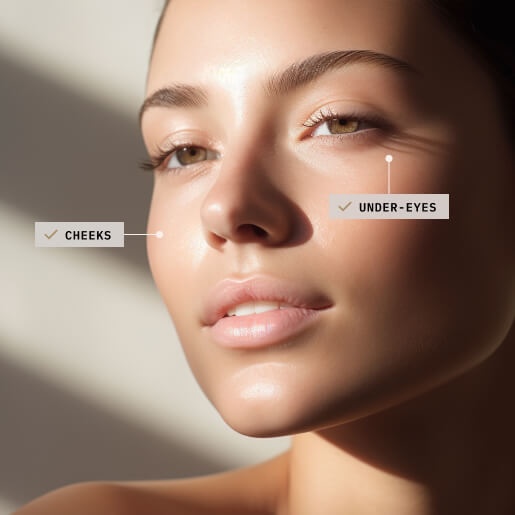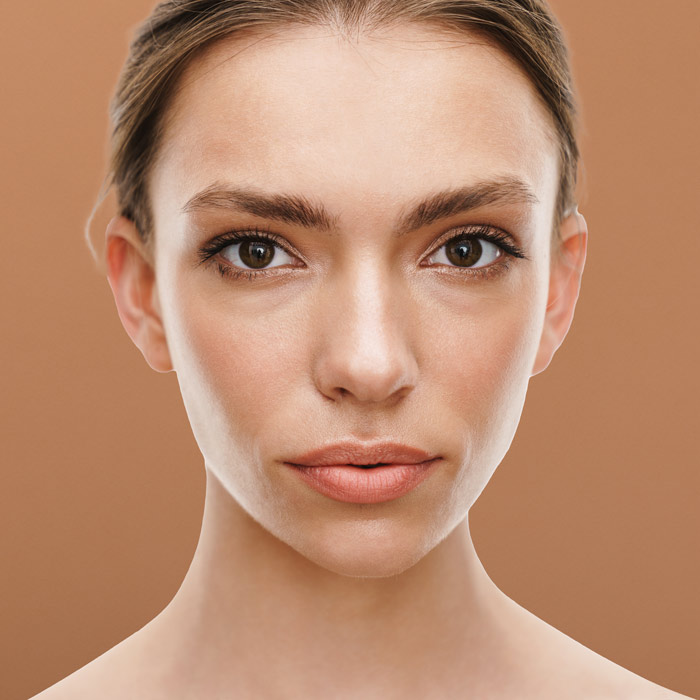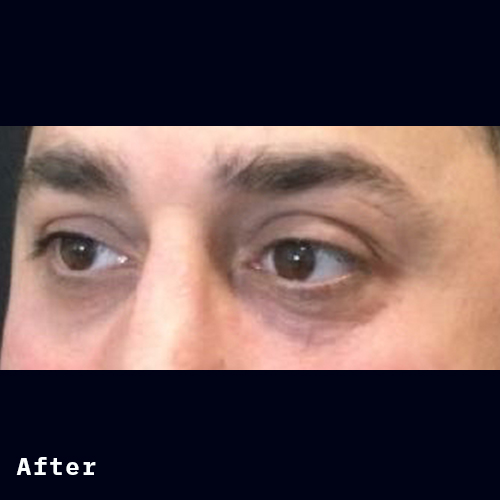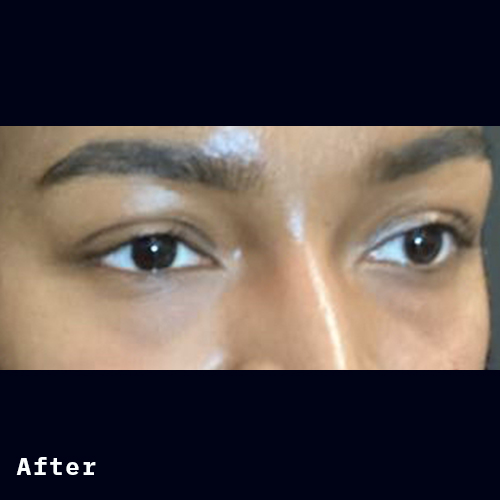aesthetic Services
Tear Trough Fillers
Non-surgical cosmetic treatment to reduce the appearance of hollow eyes, under eye bags and dark circles.
Rated 5/5

The natural ageing process and various lifestyle aspects can contribute to an aged appearance around the eyes. But, careful administration of fillers under the eyes helps replace lost volume, conceal dark circles and smooth the skin.
This results in a more youthful appearance overall. After tear trough fillers, patients feel an increased sense of confidence in their appearance - no longer worrying that they 'look tired all the time'.
How do tear trough fillers work?
Tear trough fillers are a hyaluronic acid-based injectable used to reduce dark circles, eye bags and a tired looking appearance. With minimal to no downtime, they are an effective treatment to combat tired-looking or aged eyes.
How long does a typical treatment session take?
The procedure takes around 20 minutes.
“Dr Hawkes was incredibly professional, but with a very easy and helpful manner. I always felt in very capable hands.”
What downtime is associated with a Tear Trough Filler treatment?
Dermal fillers generally have minimal downtime. Some may experience mild swelling, redness, or bruising at the injection sites, usually lasting a few hours to a couple of days. Most people can return to normal activities immediately, though it's recommended to avoid intense exercise, alcohol, and sun exposure for 24 hours.
When will I see results, and how long can I expect them to last?
You will see the results immediately. However, the final result will be visible a few weeks after treatment as the fillers need time to integrate with the surrounding tissue.
Results last 6—18 months, depending on the individual and type of hyaluronic acid used. As with all dermal filler treatments, maintenance is necessary. But, because the tear trough isn’t a very mobile place (unlike your lips or forehead), it takes your body longer to metabolise the filler.
Treatment areas Which areas can be treated?
Under-Eyes:– Fills hollow areas to reduce dark circles and shadowing, giving a more rested appearance.
Cheeks:Sometimes treated to add volume to lift and support under-eye areas, creating a smoother transition between cheeks and eyes.

Trusted Practitioner
Highly experienced and serving in multiple advisory roles, Dr Hawkes stays at the forefront of industry standards and care.
Award-Winning
Award-winning and Tatter-recommended, Dr Hawkes is honoured to be commended for her achievements.
Bespoke Treatment
Using extensive facial and ocular expertise, Dr Hawkes tailors each treatment to the individual needs and natural features.
Advanced Techniques
State-of-the-art technologies and meticulous care underscore Dr Hawkes’ dedication to continuous innovation, learning and excellent results.

Concerns Treated
Which concerns can be addressed?
Hollowness under the eyes:– Caused by factors like dehydration, lack of sleep, weight loss, or ageing.
Dark circles:– Resulting from genetics, lifestyle factors, or even allergies.
Fine lines and wrinkles:– Due to the delicate nature of under-eye skin, collagen and elastin breakdown, and environmental factors.
Tired appearance under eyes:– Creates a more refreshed, awake look by improving under-eye contours
Why choose Dr Hawkes?
Bespoke care,
natural results.
Bespoke Treatment: Dr. Hawkes meticulously formulates a personalised treatment plan specifically tailored to your individual needs, medical background, and aspirations.
Excellence in Treatment:With over 20 years of medical and surgical training, Dr Hawkes offers expertise in eye surgery, eye care and aesthetic treatments.
Top-tier Facility: Dr Hawkes is the lead Oculoplastic Surgeon at the internationally renowned Cadogan Clinic in Chelsea, London, where your safety and comfort are paramount.
Rated 5/5

TESTIMONIALS
Happy patients
Dr Hawkes' Results
Before & Afters
Frequently Asked Questions
Dr Hawkes is available to address your inquiries. Should you have questions, we kindly invite you to reach out.
ContactAre tear trough fillers safe?
Many patients question if the treatment is safe, given the delicate region under the eye. Hyaluronic acid fillers are FDA-approved, and when administered by a medical professional like Miss Hawkes, tear trough fillers are a safe and effective way to rejuvenate the under-eye area.Are tear trough fillers safe?
Are there any complementary treatments to have alongside tear trough filler?
Miss Hawkes may recommend cheek fillers alongside tear trough rejuvenation to provide adequate support for the under-eye area. Under-eye fillers can also be combined with other treatments to form a liquid facelift.Are there any complementary treatments to have alongside tear trough filler?
At what age should you undergo tear trough fillers?
While there’s no definitive age, patients typically consider tear trough fillers after age 30. Tear trough fillers are also suitable for younger patients experiencing pronounced under-eye bags and hollowness. Each patient ages differently, and Miss Hawkes will assess suitability on a case-by-case basis.At what age should you undergo tear trough fillers?
Do tear trough fillers hurt?
Tear trough fillers are minimally invasive and generally pain-free. During the treatment, Miss Hawkes applies a topical anaesthetic to reduce any discomfort. Most patients only experience mild discomfort.Do tear trough fillers hurt?
How can I extend the longevity of my treatment?
You can extend the longevity of your treatment by following these tips:How can I extend the longevity of my treatment?
- Sun protection: Use a broad-spectrum sunscreen daily, ideally with SPF 50.
- Healthy diet: Avoid processed foods and limit salt and sugar intake, especially around treatment time to reduce swelling.
- Eye skincare: Use products with ingredients like hyaluronic acid to stimulate collagen, but avoid retinol and glycolic acid before and after treatment.
- Minimise stress: Managing stress can benefit skin health, as high cortisol levels can contribute to signs of ageing.
How will the results look? – I’m worried about the overfilled ‘puffy’ look
Miss Hawkes aims to replace lost volume without creating an overfilled look. If a patient has naturally puffy lower eyelids, she may recommend alternative treatments. Miss Hawkes ensures the filler is administered proportionally to your facial structure for a natural, youthful result. Avoiding active skincare ingredients, like retinol and glycolic acid, before your appointment can help prevent irritation.How will the results look? – I’m worried about the overfilled ‘puffy’ look
What are the benefits?
Tear trough filler offers numerous benefits:What are the benefits?
- Reduction of dark circles
- Addition of volume under the eyes
- Improved skin quality under the eyes
- Reduction of fine lines and wrinkles
- Non-surgical with instant results
- Minimal to no downtime
- Enhanced sense of confidence
What are the potential side effects?
Tear trough fillers may have some side effects, which are usually mild and short-lived:What are the potential side effects?
- Common: Soreness, redness, mild swelling, or bruising at the injection site, resolving within a few days.
- Less common: Infection, which can be treated with antibiotics.
- Serious (rare): Scarring, filler migration, or vascular occlusion and blindness. Prompt medical attention is crucial if serious symptoms occur.
What can cause tear trough fillers to go wrong?
Complications are rare but can occur due to incorrect filler type, poor injection technique, or wrong filler placement. Miss Hawkes uses a cannula specifically for the under-eye area, reducing risks by avoiding blood vessel punctures.What can cause tear trough fillers to go wrong?
What happens during the recovery period?
Recovery is generally quick with minimal downtime. Miss Hawkes recommends the following:What happens during the recovery period?
- Avoid touching the tear trough area for 3 hours post-treatment.
- Do not apply pressure to the area for 6 hours.
- Refrain from strenuous activity for 48 hours.
- Avoid facials, skin treatments, and chemical peels for 2 weeks.
- Do not apply makeup for 24 hours. If makeup is essential for work, consider scheduling a day off as a precaution.
- Avoid alcohol and blood thinners for 24 hours.
What happens during the treatment?
The treatment involves the following steps:What happens during the treatment?
- Miss Hawkes will review your medical history and examine your under-eye area, discussing treatment goals and any associated risks.
- She will cleanse the area with an antiseptic and apply a topical anaesthetic.
- Using a cannula, she will inject small amounts of filler precisely under the eye, then massage the area to ensure a smooth result.
- Following the procedure, you’ll be able to review the results with a mirror, and aftercare advice will be provided.
What if I don’t like the results?
Dermal fillers are dissolvable. In the unlikely event you are dissatisfied with the results after two weeks, Miss Hawkes can use hyaluronidase to dissolve the filler, returning the under-eye area to its original state within 48 hours.What if I don’t like the results?
What is a liquid facelift?
A liquid facelift is a non-surgical procedure using hyaluronic acid filler to lift and rejuvenate eight areas of the face, including:What is a liquid facelift?
- Jawline fillers
- Lower cheek filler
- Mouth corners
- Nasolabial folds
- Pre-jowl folds
- Tear trough fillers
- Upper cheek filler
What is hyaluronic acid?
Hyaluronic acid is a naturally occurring gel-like substance in the body that holds over 1,000 times its weight in water. Its humectant properties make it ideal for smooth, hydrated skin.What is hyaluronic acid?
What is the best treatment for the tear trough region – Botulinum Toxin or dermal filler?
What is the best treatment for the tear trough region – Botulinum Toxin or dermal filler?
- Botulinum Toxin: Botulinum Toxin is a neurotoxin that smooths fine lines and wrinkles.
- Dermal fillers: Dermal fillers, primarily hyaluronic acid, are ideal for filling hollow areas under the eye, addressing common signs of ageing in this region. They can also be used with Botulinum Toxin around the eye for enhanced rejuvenation.
What is the tear trough area?
The tear trough area is located between the lower eyelid and the cheek. This area can develop hollows or wrinkles over time, contributing to a tired appearance.What is the tear trough area?
Which cosmetic concerns does an under-eye filler procedure treat?
Tear trough fillers address various concerns, including:Which cosmetic concerns does an under-eye filler procedure treat?
- Hollowness: Caused by factors like dehydration, lack of sleep, weight loss, or ageing.
- Dark circles: Resulting from genetics, lifestyle factors, or even food allergies.
- Fine lines and wrinkles: Due to the delicate nature of under-eye skin, collagen and elastin breakdown, and environmental factors.
Who is the ideal candidate for a tear trough filler treatment?
Suitable candidates include patients with hollowing, dark circles, or deep lines under the eyes. Tear trough fillers are ideal for addressing tear trough deformity, often caused by age-related changes to the orbital fat, which results in a more youthful appearance.Who is the ideal candidate for a tear trough filler treatment?
Why should I choose Miss Elizabeth Hawkes?
Miss Elizabeth Hawkes is a consultant ophthalmic and oculoplastic surgeon with extensive expertise in facial aesthetics, especially around the delicate under-eye area. Her medical background offers the unique advantage of evaluating under-eye issues that may indicate underlying health conditions, ensuring a comprehensive and safe approach to treatment.Why should I choose Miss Elizabeth Hawkes?
Why should I choose tear trough filler?
Tear trough fillers are ideal for reducing the appearance of hollow tear troughs, dark circles, and eye bags, restoring volume and confidence. This treatment can achieve remarkable, rejuvenating results, particularly for patients experiencing an aged or tired appearance due to changes in facial anatomy.Why should I choose tear trough filler?
Book a Consultation
If you would like to book a consultation, please use the form below. We will respond within 2 working days.




